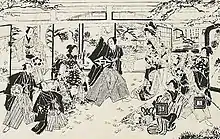Suehiro-za (Nagoya)
The Suehiro-za (末広座) was a kabuki theatre in Nagoya, central Japan.[1] It was located in Suehiro-chō.[2]

History
In Nagoya of the Meiji era at that time a number of theatres existed, such as the Chitose-za (千歳座) in Minamikuwana-machi (南桑名町), Shinmori-za (新守座) in Motoshige-chō (本重町), Onu-za (音羽座) in Minamifushimi-chō (南伏見町), Hoso-za (宝生座) in Ōsu, and Misono-za.[3] The theatre was founded under a different name originally[4] in January 1883.[2]
Among the many noted actors were Nakamura Denkurō VI (1859-1923), who was born in Suehiro-chō and became of a member of the children actors troupe at the Suehiro-za.[5] Ichikawa Chūsha VII (1860-1936) and Ichikawa Danzō VII (1836-1911) appeared together in May 1909,[6][7] as well as Nakamura Tokizō III (1895-1959) appeared here in May 1917.[8]
The building was bought by Shochiku, a cinema chain which has its roots in kabuki production, and converted into a movie theatre in 1927. Under its new name Shochiku-za (松竹座) it became one of the leading cinemas in town and was also used for revue shows. It was destroyed in the bombing of Nagoya in World War II.[2]
References
- A Handbook for Travellers in Japan, p. 265, at Google Books
- "名古屋市中区の映画館 - 消えた映画館の記憶".
- "名古屋財界の集まり・九日会を作る|愛知千年企業-明治時代編". www.nagoya-rekishi.com.
- "愛栄座のあった場所と、いつからいつまであったのかを知りたい。 | レファレンス協同データベース".
- "NAKAMURA DENKURÔ VI". www.kabuki21.com.
- "ICHIKAWA DANZÔ VII". www.kabuki21.com.
- "ICHIKAWA CHÛSHA VII". www.kabuki21.com.
- "NAKAMURA TOKIZÔ III". www.kabuki21.com.